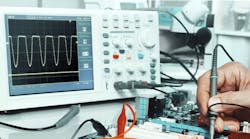The vector network analyzer (VNA) is an essential test instrument in the RF/microwave industry. They are used in a wide range of applications for both design validation and manufacturing production testing. In the primer, “Introduction to VNA Basics,” Tektronix discusses VNAs in detail, explaining why they are used, how they compare to other RF test instruments, and much more.
According to the primer, the VNA dates back to around 1950. They make many modern technologies possible, as all wireless systems contain components in which performance can be verified by using a VNA. Specifically, an RF front end consists of various components, such as filters and amplifiers, which can be tested with a VNA.
The primer then describes the VNA’s basic operation. In simple terms, a VNA contains a source that generates a known stimulus signal, as well as a set of receivers. This stimulus signal is injected into the device-under-test (DUT). The signal that is reflected from the input of the DUT and the signal that passes through the DUT are both measured by the VNA receivers. These signals are then compared to the known stimulus signal. Moreover, the primer describes four important VNA specifications: frequency range, dynamic range, trace noise, and measurement speed. Each one is explained in greater detail.
The differences between a VNA and a spectrum analyzer are explained. The primer also explains S-parameters, which are the fundamental VNA measurement. The next topic described is the functionality of a VNA that allows S-parameter measurements to be achieved. Moreover, the importance of VNA calibration is emphasized. Calibration is required to reduce errors that can affect measurements. According to the primer, the three main types of measurement error are systematic errors, random errors, and drift errors.
Different types of VNA measurements are presented. Swept-frequency measurements are explained, with example measurements of both a passive filter and an antenna. Time-domain measurements are also described, as well as swept-power measurements. The last type of measurement explained is multi-port component testing.
Tektronix Inc., 14150 SW Karl Braun Dr., Beaverton, OR, 97077; (800) 833-9200

